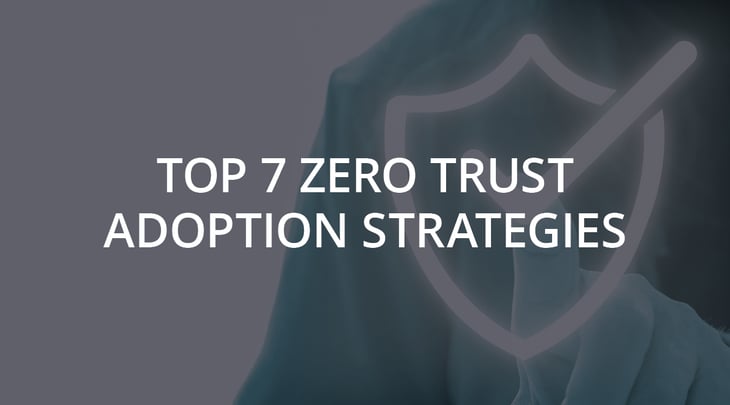Top 7 Zero Trust Adoption Strategies
Reduce your organization’s risk through a Zero Trust strategy – saving money and time by further securing your organization from attacks and breaches.
Read on to learn the top 7 adoption strategies to increase your organization’s security...
___________________________________________________
Assuming your organization is secure, based on a firewall, is no longer adequate. Zero Trust is a security strategy that enables organizations to approach data security and verification with a focus on an increasingly mobile, remote, and versatile workforce environment.
What is Zero Trust?
Zero Trust is a broad strategy for modern security that reconciles today's complex environment and mobile workforce to protect people, devices, and data wherever they are located. Unlike traditional approaches that attempt to force all assets onto a “secure and compliant” network, Zero Trust focuses on the security and compliance of assets regardless of their physical or network location. Organizations must stop believing the fallacy that things behind the firewall are safe. Regardless of where a request originates or what resource it accesses, Zero Trust teaches the importance of “never trust, always verify.”
Top 7 Adoption Strategies
A Zero Trust framework requires implementing controls and technologies across all foundational elements: identities, devices, applications, data, infrastructure, and networks. Microsoft published an eBook examining Zero Trust based on an executive roundtable discussion. We have compiled the top 7 strategies to adopt a Zero Trust framework for your organization:
-
Use Identities to Control Access:
When any identity (representing people, services, and IoT devices) attempts to access any resource, security controls should verify the identity with strong authentication, ensure access is compliant and typical for that identity, and confirm that the identity follows least privilege access principles.
-
Elevate Authentication:
Incorporating multifactor authentication or continuous authentication into your identity management strategy can substantially improve your organization’s information security posture.
By extending identity management with continuous authentication capabilities, organizations can now validate identity when a user’s IP address or routine behavior pattern changes.
-
Passwordless Authentication:
Passwordless authentication replaces the traditional password with two or more verification factors secured with a cryptographic key pair. When registered, the device creates a public and private key. The private key can be unlocked using a local gesture, such as a PIN or biometric authentication (fingerprint scan, facial recognition, or iris recognition).
-
Segment Your Corporate Network:
Segmenting networks and conducting deeper in-network micro-segmentation is important for Zero Trust because in a mobile- and Cloud-first world, all business-critical data is accessed over network infrastructure. Networking controls provide critical functionality to enhance visibility and help prevent attackers from moving laterally across the network.
-
Secure Your Devices:
With the Zero Trust model, the same security policies are applied whether the device is corporately owned or a personally owned device, also called a “bring your own device” (BYOD). Corporate, contractor, partner, and guest devices are treated the same whether the device is fully managed by IT or only the apps and data are secured. And this is true whether these endpoints—PC, Mac, smartphone, tablet, wearable, or IoT device—are connected using the secure corporate network, home broadband, or public internet.
-
Segment Your Applications:
Benefitting fully from Cloud apps and services requires finding the right balance between providing access and maintaining control to ensure that apps- and the data they contain- are protected. Apply controls and technologies to discover shadow IT, ensure appropriate in-app permissions, gate access based on real-time analytics, monitor for abnormal behavior, restrict user actions, and validate secure configuration options.
-
Define Roles and Access Controls:
With the rapid rise in remote work, organizations must consider alternative ways of achieving modern security controls. It’s useful to operationalize roles and tie them to a policy as part of authorization, single sign-on, passwordless access, and segmentation. However, each role defined must be managed now and in the future, so be selective about how many roles you create to help manage challenges later.
How Interlink Can Help
Developing a holistic strategy to address Zero Trust is critical for an organization’s security. Organizations should start small and build confidence before rolling out Zero Trust across their entire organization. Usually, this means taking a planned phased approach that targets specific areas based on your organization’s environment.
This can be a challenging process to navigate – take advantage of Interlink’s expertise and experience to save your organization time and headaches while reducing your risks. Contact Interlink today to receive a free consultation!



